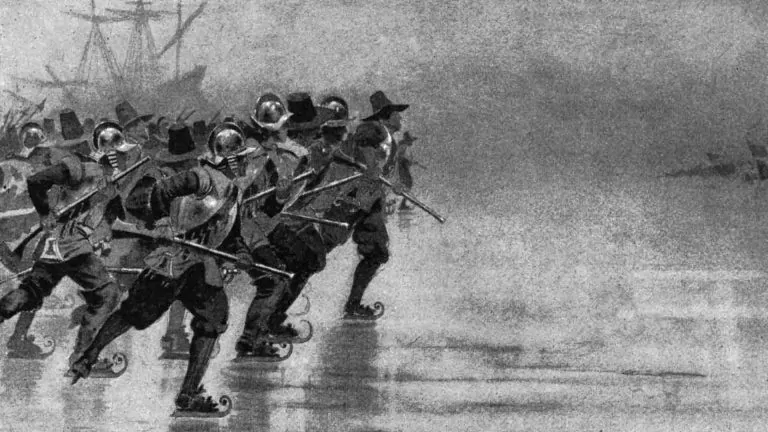You can download or listen to the podcast version (5 minutes) here.
****
Paul Simon once sang that the nearer your destination, the more you keep slip sliding away. While it’s a song about your journey through life and the places you visit, it’s also a sentiment that anyone in a northern, icy, country can understand. As a Canadian, I can confidently say we understand ice. It’s something that defines us in a way that’s hard to explain. The waters of the North are covered in ice much of the year. The ground in many areas is frozen with permafrost. The highways in the winter are either covered in treacherous black ice, or in some areas ice itself acts as the winter road. In the cities we learn to walk stiff legged like a penguin to avoid sliding on the ice. And we’ve even made ice our ally, playing hockey or figure skating to turn ice from foe to friend.
Though we Canadians may know ice, we’re not the only ones. The Dutch have a reputation as speed skaters par excellence, having won bronze, silver and gold at the 2014 Sochi Olympics. In English literature, the familiarity of the Dutch with skating has survived as the tale of Hans Brinker or The Silver Skates. Though the Dutch may not know the snowfalls that can leave you trapped in your house for days, or the blizzards that can leave you unable to see more than a couple of feet in front of you, they do understand ice and maybe in a way the rest of us never will.
Historically, for the Dutch skating has not been a sport or a playtime activity, but a practical way of getting around. Much of the Netherlands is located below sea level and large chunks of the country have even been reclaimed from the seas. This is a country with a lot of experience dealing with water. Not surprisingly, it’s also a land crisscrossed by canals because they’re necessary for drainage, and stopping the sea from taking back the land stolen away from it.
Zip vs. slip
Come winter, and especially the cold winters that the Netherlands frequently experienced in the 1500 and 1600s, these canals freeze. With that many canals, that’s a lot of ice. And since there are relatively few bridges spanning the rivers and canals, knowing how to skate gave you a really fast way to get around. You could get anywhere you wanted, and could get away from anywhere you didn’t want to be.
Starting in the 1560s, the Dutch began to battle their colonial overlords, the Spanish. With on-again, off-again battles raging over the years, the troubles came to a head near Amsterdam in 1572. The small Dutch fleet, highly maneuverable against the much larger Spanish vessels, was frozen into the ice in the port of Amsterdam. Though the Dutch fleet was immobile, the cold weather had brought the Spanish similar problems and they were unable to attack the Dutch city with their fleet.
Forced to disembark, the Spanish started to cross the ice to the city on foot, and this was their fatal mistake. Walking gingerly in the penguin walk that natives of northern climates know well, the Spanish made slow progress towards the city.
Yet as the Spanish struggled, coming at them with unbelievable speed were the Dutch soldiers. They would swiftly skate just within musket range, fire, and then skate away to reload. The speedy attack and retreat gave the Dutch incredible striking power and left nothing for the Spanish to fire at in return.
The Spanish commander, the infamous Duke of Alva, was grudging in his respect for the Dutch. He ordered a swift retreat back to the Spanish boats (or as swift a retreat as the ice would allow), having suffered hundreds of deaths at the hands of the Dutch.
The Duke did manage to kill a few Dutch soldiers and capture their skates. Acknowledging the innovative tactics of his enemies, he sent skates back to Spain and ordered that 7,000 pairs be made. From then on, soldiers posted to the Dutch frontier were all given skating lessons. It gave the Spanish increased mobility, but learning to skate and to skate well is not the work of a few lessons but of years of practice. The Dutch, as it were, could still skate circles around their foe.
The ice-ing on the cake?
While ice played a factor in the Dutch eventually winning their independence from the Spanish after 80 years of war, there were other factors, too. They formed alliances with other powers, and the women learned to shoot and guard the city walls while the men attacked the Spanish. But throughout that long war, strategic flooding of the lowlands, and its wintertime counterpart of skating played a role that the Spanish never could overcome.
Though there were a lot of reasons that the Dutch beat the Spanish, it certainly helped that the Spanish learned a bit of what Paul Simon would later sing about: The nearer your destination, the more you keep slip sliding away.
This article is taken from an episode of James Dykstra’s History.icu podcast, where history is never boring. Check out more episodes there or on Spotify, Google podcasts, or wherever you find your podcasts.















